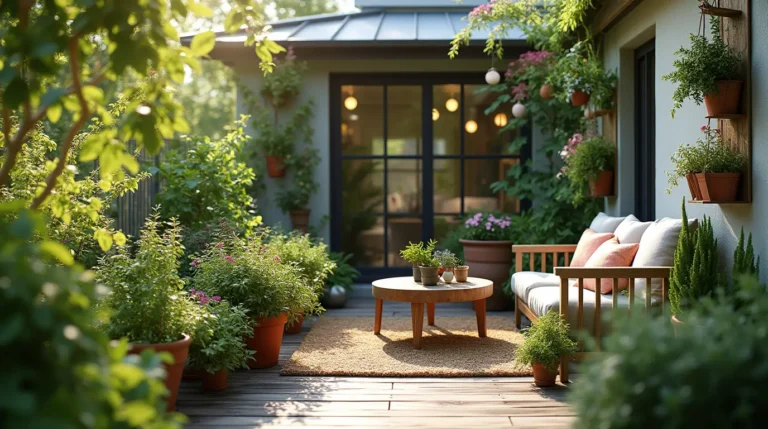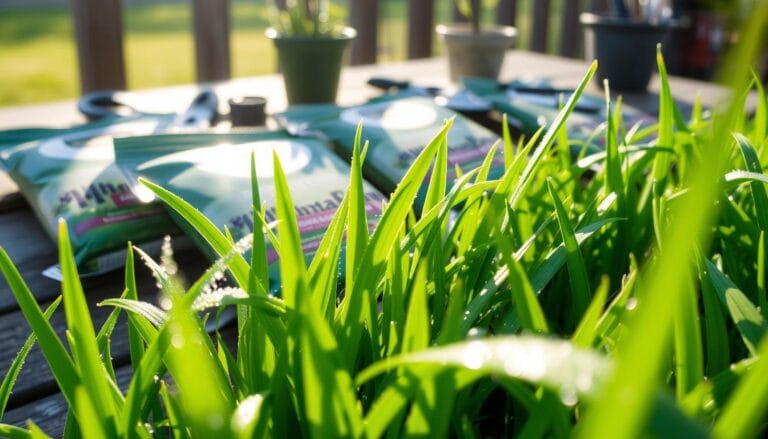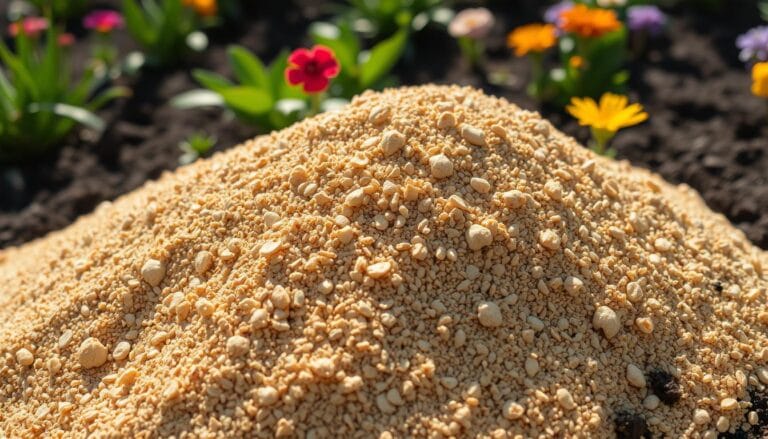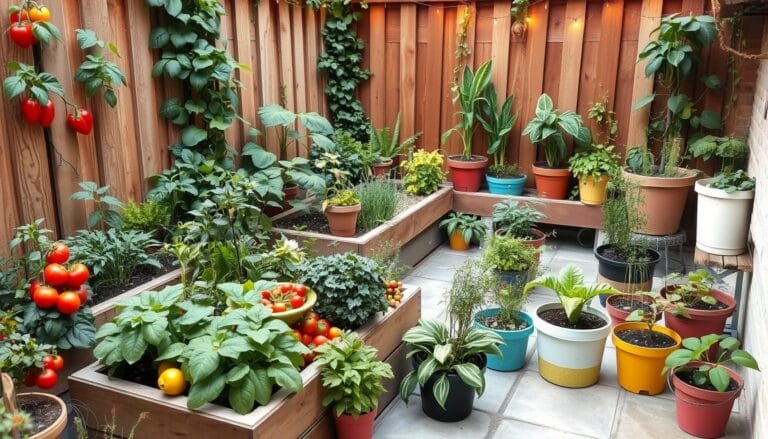Apartment Patio Garden: How To Avoid Common Maintenance Mistakes

I remember my first try at an apartment patio garden. It was a mess. I didn’t know about planning, and my plants died. But I learned and now I want to share what I know. A well-kept garden can boost your mood and health.
Creating a garden in a small space is tough. But with the right info, you can make a beautiful outdoor area. This can improve your life a lot.
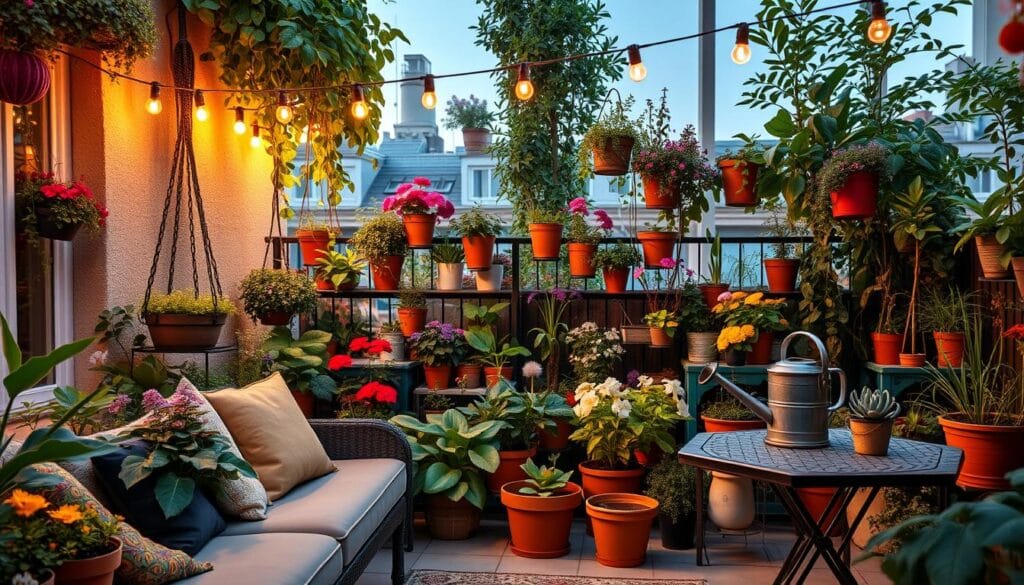
Small space gardening is more than just planting. It’s about making a space that’s good for the planet and wildlife. This guide will help you avoid mistakes and make a great garden, no matter your skill level.
Table of Contents
Key Takeaways
- A well-maintained apartment patio garden can bring numerous benefits, including mental health and physical benefits, and a sense of satisfaction and purpose.
- Proper planning and research are crucial when creating a small space garden, including considering local climate and light conditions.
- Regular fertilization and proper drainage are essential for the health and survival of container plants.
- Choosing the right plants for your apartment patio garden, including a mix of perennials and annuals, can ensure continuous blooms throughout the growing season.
- Incorporating windbreaks and flowering bulbs can improve plant survival rates and enhance biodiversity in your urban outdoor living space.
- Average annual spending on plants and accessories for balcony gardeners is approximately $150, highlighting the economic aspect of urban gardening.
Getting Started With Your Apartment Patio Garden
Starting my apartment patio garden, I focus on balcony garden design. It’s key to enhance my outdoor area. First, I assess my space and sunlight. Most plants need six to eight hours of direct sunlight daily.
Choosing the right plants is crucial. I must pick ones that match my patio’s sunlight. Local climate conditions also play a big role. I need to consider temperature, humidity, and wind to ensure my plants do well.
Basic Tools and Supplies Needed
To start my garden, I gather basic tools and supplies. I need containers, soil, fertilizer, and watering cans. It’s important to choose lightweight containers for my balcony. A tiered planter can save space and add beauty to my outdoor apartment decor.
Here are some essential items to get started:
- Containers with good drainage
- Potting soil designed for containers
- Water-soluble fertilizer
- Watering cans or self-watering pots
Smart Container Selection for Urban Gardens
Choosing the right containers is key for a successful urban garden. I look at the weight, drainage, and weather resistance of containers. There are many types, like plastic, fiberglass, and fabric grow bags, each with its own pros and cons.
Plastic pots are cheap but can crack and fade. Fiberglass containers are durable and weather-resistant. Fabric grow bags add a decorative touch.
When picking a container, size and material matter. Use pots a bit larger than needed for root growth. Also, choose a container that drains well to avoid soggy soil. These tips help create a beautiful, thriving garden in the city.
Some top container picks for patio gardens include:
- EarthBox Original Planter Box: 29” L x 13.5” W x 11” H, holds three gallons of water
- EarthBox Junior Planter Box: Approximately 2 feet long and 10 inches wide, ideal for herbs
- EarthBox Root & Veg Planter Box: 16 inches deep, suitable for root crops like carrots and beets
By picking the right containers and following these tips, you can have a thriving patio garden. Remember to think about size, material, and drainage for the best results.
Soil Preparation and Quality Control
Exploring small space gardening, I see how vital soil prep and quality control are. For balcony gardens, the right potting mix is key. It helps with water absorption and nutrient delivery, crucial for plants.
In small space gardening, picking the right potting mix is essential. It should hold moisture but also drain excess water to avoid root rot. Peat-based and coconut coir-based mixes are good choices. Adding perlite or vermiculite helps with drainage too.
Soil Testing and Amendment Tips
Soil testing is a must to check pH and nutrient levels. Based on the results, you can add compost or well-rotted manure. This boosts soil quality by up to 40%. For urban gardens, consider your plants’ needs. Tomatoes like slightly acidic soil, while basil prefers neutral.
In balcony garden design, soil prep and quality control are vital for plant health. The right potting mix, drainage, and soil testing and amending are key. These steps help create a thriving garden in small spaces. Whether it’s herbs, veggies, or flowers, the soil is the secret to success. With the right approach, small space gardening and urban living can be rewarding.
Watering Wisdom for Container Plants
Container gardening is all about watering plants right. It’s key for keeping your outdoor space looking good. You need to pay close attention to how you water your plants.
Some plants, like cacti and succulents, don’t need much water. They do well in dry, hot places. This makes them great for people who don’t have a lot of time to water.
Here are some tips for watering your container plants:
- Water your plants in the morning to allow the plants to absorb the water throughout the day
- Check the soil moisture by sticking your finger into the soil up to the first knuckle
- Use a well-draining potting mix to prevent waterlogged soil
By using these tips, you can make your container garden beautiful and healthy. Pick plants that fit your climate and water them right. With the right care, your outdoor space will look amazing.
| Plant Type | Watering Needs |
|---|---|
| Cacti and Succulents | Infrequent watering, allowing soil to dry out completely |
| Drought-Adapted Plants | Less frequent watering, with a focus on well-draining soil |
| Traditional Annuals | More frequent watering, with a focus on consistent moisture |
Knowing what your plants need is key to a great container garden. It will make your outdoor space happy and beautiful. Happy gardening!
Space-Saving Design Strategies
When you’re landscaping your apartment patio, using space wisely is key. One great way to do this is by using space-saving design strategies. These can turn your small patio into a beautiful and useful outdoor space.
Vertical gardening, like hanging planters or living walls, is a smart choice. It makes the most of your space. Also, setting up plants on different levels adds depth and interest. Plus, picking furniture that’s compact helps create a cozy spot without using too much room.
Here are some tips for using space-saving designs in your patio:
- Use hanging planters or living walls to add greenery without using too much floor space
- Incorporate multi-level plant arrangements to create depth and interest
- Choose compact furniture that can be easily rearranged or stored to create a cozy seating area
By using these space-saving strategies, you can make your patio both beautiful and useful. Whether you want a place to relax or entertain, small space gardening can be a fun and rewarding project.
| Design Strategy | Benefits |
|---|---|
| Vertical Gardening | Maximizes space, adds visual interest |
| Multi-level Plant Arrangements | Creates depth, adds visual interest |
| Compact Furniture Integration | Creates functional and comfortable seating area |
Plant Selection for Small Space Success
Choosing the right plants is key for a great balcony garden. You can pick from herbs, veggies, and flowers for your container garden. Plants like Kalanchoe, Coleus, and Impatiens do well in different light conditions.
In urban outdoor living areas, pick plants that handle shade or sun well. Mojito Mint keeps rodents away with its smell. Mix plants with different needs for a lively garden.
Here are some tips for picking plants for your container gardening project:
- Choose plants that fit your climate and sunlight conditions
- Select a variety of plants with different growth habits and requirements
- Consider using compact or dwarf varieties of plants to save space
By following these tips and picking the right plants for your balcony garden design, you can make a beautiful garden in small spaces. Make sure to meet each plant’s needs, like watering and fertilizing, for a great urban outdoor living experience.
| Plant | Sunlight Requirements | Watering Needs |
|---|---|---|
| Kalanchoe | Full sun to partial shade | Low to moderate |
| Coleus | Partial shade to full sun | Moderate to high |
| Impatiens | Partial shade to full sun | High |
Common Pest Management in Urban Settings
Urban gardening is all about keeping your garden healthy and pest-free. Knowing the common pests and how to stop them is key. Integrated pest management (IPM) can cut down pesticide use by up to 70%.
In cities, pests like carpenter ants and bed bugs can be a big problem. To keep them away, seal up any gaps and keep your garden tidy. Apartment patio landscaping can also help, using plants and materials that pests don’t like.
Here are some patio garden ideas to fight pests:
- Use physical barriers to prevent pests from entering your garden
- Keep your garden clean and free of debris
- Use organic mulch to reduce soil moisture evaporation
- Implement IPM techniques to reduce pesticide usage
By using these tips, you can make your urban garden a pest-free haven. Always choose eco-friendly practices for a healthy garden that lasts.
| Pest | Size | Prevention Tips |
|---|---|---|
| Carpenter Ants | 1/4 to 1/2 inch | Seal cracks and crevices, keep garden clean |
| Bed Bugs | 3/16 inch | Use mattress encasements, wash bedding regularly |
| Cockroaches | 1.5 to 2 inches | Keep garden clean, remove debris, use traps |
Weather Protection Techniques
Exploring small space gardening, I’ve learned how vital it is to shield our outdoor spaces from harsh weather. A smart balcony garden design can handle strong winds, heavy rain, and intense sun. First, picking weather-resistant materials for furniture and decor is key.
Some important weather protection tips include:
- Choosing lightweight, strong materials for planters and furniture to avoid wind damage
- Installing a drip irrigation system to save water and fight dry spells
- Picking plants that can handle extreme temperatures, like pansies that grow well in cold
By using these methods, you can make a small space garden that’s both strong and beautiful. It can make your outdoor living area better, no matter the sun or shade. For example, trellises and climbing plants can make your balcony garden up to 50% bigger, perfect for vertical gardening.
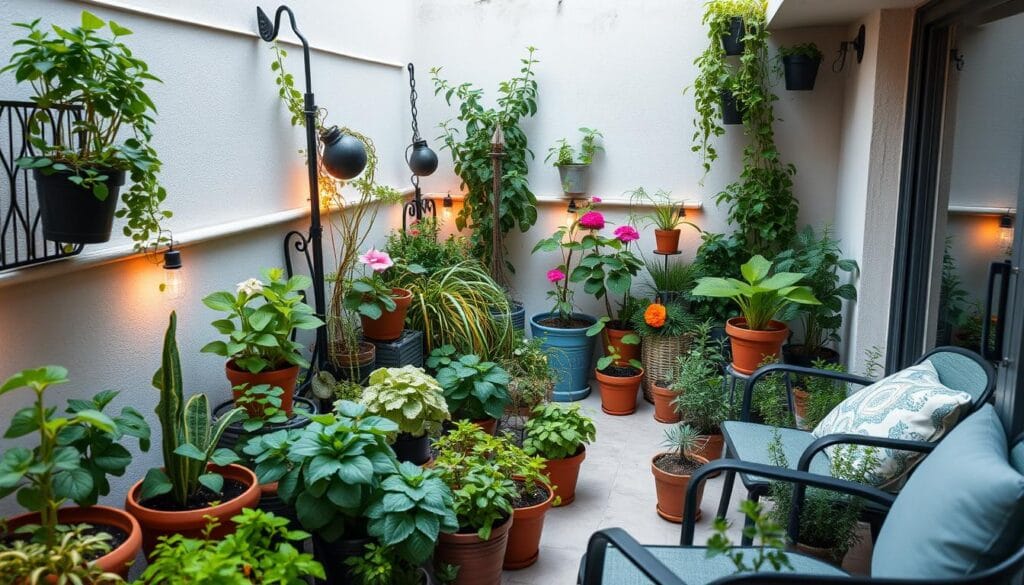
It’s also important to think about what your plants need and the local weather. This way, you can make a peaceful, green oasis in the city. It will not only look great but also offer a calm escape from city life.
| Weather Condition | Protection Technique |
|---|---|
| High Winds | Use lightweight, sturdy materials for planters and furniture |
| Heavy Rainfall | Incorporate a drip irrigation system to combat dry spells and reduce water waste |
| Scorching Sunlight | Select plants that are tolerant of extreme temperatures and weather conditions |
Seasonal Maintenance Calendar
As an apartment gardener, I’ve learned that regular maintenance is key. It keeps my outdoor decor thriving. I follow a seasonal maintenance calendar to keep my container gardening healthy and beautiful all year. Here, I’ll share the essential tasks for spring, summer, and fall.
In spring, I clean and inspect my containers, prune plants, and add fresh soil. It’s also the best time to plant cool-season veggies like broccoli and cabbage. As summer comes, I focus on watering, fertilizing, and watching for pests. In fall, I get my garden ready for winter by winterizing containers, pruning, and planting bulbs for spring.
Spring Preparation Tasks
- Clean and inspect containers
- Prune plants
- Add fresh soil
- Plant cool-season vegetables
Summer Care Routines
- Regular watering
- Fertilizing
- Monitoring for pests
Fall Winterizing Steps
- Winterize containers
- Prune back perennials
- Plant spring-flowering bulbs
By sticking to this seasonal maintenance calendar, I enjoy a thriving garden all year. These tips are great for both seasoned and new gardeners. They help keep your garden healthy and looking its best.
| Season | Tasks |
|---|---|
| Spring | Clean and inspect containers, prune plants, add fresh soil, plant cool-season vegetables |
| Summer | Regular watering, fertilizing, monitoring for pests |
| Fall | Winterize containers, prune back perennials, plant spring-flowering bulbs |
Fertilization and Feeding Guidelines
Exploring urban outdoor living, I’ve learned how vital fertilization and feeding are for my balcony garden. In small space gardening, giving plants the right nutrients is key. Early spring is the best time to fertilize, as plants need more nutrients then.
Organic fertilizers are excellent for providing essential nutrients like nitrogen, phosphorus, and potassium. They also help improve soil structure and water retention. Options include compost from kitchen and garden waste and sheep’s wool, a natural slow-release fertilizer. But, it’s important not to over-fertilize, as it can harm plants. Instead, stick to the recommended amount.
Here are some tips for fertilizing your urban outdoor living space:
- Apply compost once at the beginning of the season
- Reapply sheep’s wool pellets throughout the summer
- Conduct soil analysis to determine the best fertilizer for your specific soil conditions
By following these guidelines and using organic fertilizers, you’ll support healthy plant growth and help the environment. As you care for your balcony garden, remember that small space gardening needs careful attention. With the right fertilization and feeding, you can enjoy a thriving and sustainable urban oasis.
| Fertilizer Type | Application Frequency | Benefits |
|---|---|---|
| Compost | Once at the beginning of the season | Improves soil structure and water retention |
| Sheep’s wool | Throughout the summer | Provides slow-release nutrients |
Creating a Self-Sustaining Garden Ecosystem
Exploring apartment patio landscaping, I see the need for a self-sustaining garden. It’s about making my outdoor space beautiful and eco-friendly. With the right ideas, my garden can flourish and help the planet.
Companion Planting Strategies
Companion planting is key to a self-sustaining garden. It’s about pairing plants that help each other grow and fight pests. For instance, marigolds keep nematodes away from tomatoes, and basil makes herbs taste better.
Natural Composting Methods
Composting is vital for a self-sustaining garden. It turns kitchen and yard waste into fertilizer, reducing the need for chemicals. This method is good for my garden and the environment.
- Reduce waste by composting kitchen scraps and yard waste
- Create a natural fertilizer for my patio garden
- Promote sustainable urban gardening practices
By using these methods, my garden becomes a thriving, eco-friendly oasis. It’s a showcase of the best in patio garden ideas and urban gardening tips.
Conclusion: Nurturing Your Urban Oasis
Reflecting on our journey in small space gardening, I’m filled with inspiration. Creating a balcony garden is more than growing plants. It’s about making a personal sanctuary in the city.
Our exploration showed the many benefits of urban gardening. It improves mental health, reduces stress, and boosts air quality. Plus, growing your own food brings joy. Studies found gardeners have 6.6% higher well-being and 4.2% less stress than non-gardeners.
Starting your own small space gardening journey is exciting. Spending 15-30 minutes a day can make a big difference. It’s good for you and the planet. By caring for your balcony garden, you create a peaceful space and help the environment.
FAQ
What are the benefits of having an apartment patio garden?
An apartment patio garden can boost your mental and physical health. It gives you a sense of purpose and satisfaction. Plus, you can create a beautiful oasis in a small urban space.
What are some common mistakes to avoid when maintaining an apartment patio garden?
Avoid overwatering, underwatering, and poor soil quality. Know your plants’ needs and create a healthy garden ecosystem.
How do I choose the right containers for my apartment patio garden?
Look for containers that are light, drain well, and resist weather. Plastic, fiberglass, and fabric grow bags are good options for urban gardening.
How do I prepare the soil for my apartment patio garden?
Good soil is key for a thriving garden. Choose the right potting mix and ensure it drains well. Regularly test and amend the soil to keep nutrients balanced.
How often should I water my apartment patio garden?
Watering depends on climate, plant type, and container size. Watch your plants’ needs to avoid over or underwatering.
How can I maximize space in my apartment patio garden?
Use space-saving designs like vertical gardening and multi-level plants. Compact furniture can also help make your garden functional and beautiful.
What plants are best suited for an apartment patio garden?
Choose plants that do well in small spaces, like herbs, vegetables, and flowering plants. Pick ones that fit your patio’s climate and sunlight.
How can I manage pests in my apartment patio garden?
Use natural pest control and prevent infestations. Safe pesticides can also be necessary for a healthy garden ecosystem.
How do I protect my apartment patio garden from extreme weather conditions?
Use materials and designs that resist wind, rain, and sun. This keeps your plants thriving and resilient.
What are the key tasks for seasonal maintenance in an apartment patio garden?
Keep your garden healthy all year. Tasks include spring prep, summer care, and fall winterizing. This ensures your plants stay healthy and your garden looks great.
How do I properly fertilize and feed my apartment patio garden plants?
Learn about fertilizers and how to use them. This creates a nutrient-rich soil that supports your plants’ growth.
How can I create a self-sustaining garden ecosystem in my apartment patio?
Use sustainable gardening like companion planting and natural composting. Also, conserve water to create a balanced and thriving urban garden.

